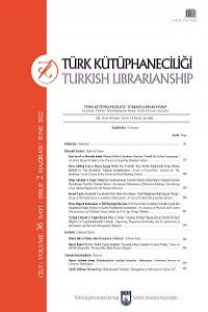Bilgi Yönetimi Süreçlerini Geliştirmede Enformasyon Sistemlerinin Kullanılması: Çalışma Ortamı, İş Özellikleri ve İş-Teknoloji Uyumunun Rolü
Bu makale bireyin çalıştığı ortam, iş özellikleri ve bilgiyle bağlantılı iş gereksinmelerinin, işteknoloji uyumu ile enformasyon sistemlerinin Bilgi Yönetimi BY etkinliklerinde kullanılması arasındaki ilişkileri nasıl etkilediği üzerine odaklanmaktadır. BY ve Bilgi Yönetimi Sistemleri BYS hakkındaki literatür, ilgili yapıları ve bunların boyutlarını belirlemek üzere incelenmiştir. Bu analize dayanılarak bir model önerilmiş ve model test edilmiştir. Bulgularımız, yalnızca işlere uygun enformasyon teknolojisi araçları sağlamanın, bilginin elde edilmesi, aktarılması ve tekrar kullanılmasını geliştirmede işe yarayabileceğinin garantisi olmadığını ortaya çıkarmıştır. Belirli çalışma ortamlarının getirdiği belirli iş özellikleri, bilginin kullanılması için daha büyük bir gereksinme ve olanak üretmektedir. Bu etkenler işteknoloji uyumu ile BY amaçları için enformasyon sistemlerinin kullanılması arasındaki ilişkiyi değişikliğe uğratmaktadır: Bilgiye ilişkin etkinlikleri yürütme gereksinmesi ve olanağı ne kadar çok olursa, iş-teknoloji uyumu ile enformasyon sistemlerinin kullanılması arasındaki ilişki de o kadar güçlü olur.
Anahtar Kelimeler:
Bilgi yönetimi, enformasyon sistemleri, iş-teknoloji uyumu, iş tasarımı.
Using Information Systems to Leverage Knowledge Management Processes: The Role of Work Context, Job Characteristics and Task-Technology Fit
This study focuson how anindividual's particularworkcontext,job characteristics andknowledge-relatedjobrequirementsaffectthe relationship betweentask-technologyfit TTF andthe use ofinformation systems IS inknowledge management activities. TheliteratureonKnowledge Management KM and Knowledge Management Systems KMS isreviewedto identifyrelevantconstructs and their dimensions. Based onthisanalysis,amodel isproposedandtested.Our findings suggestthat providing appropriateIT toolsthatfit tasks aloneis no guarantee that they will be employed to leveragetheacquisition,transferand reuse of knowledge.Certaincharacteristicsofjobs, driven by particularworkcontexts, generategreater needandopportunityforknowledgeuse.These latter factors moderate therelationshipbetween TTFandactual useofISfor KM purposes:thegreaterthe needand opportunity to conductknowledgerelated activities,thestrongertherelationshipbetweenTTFand actual IS use
Keywords:
Knowledgemanagement, informationsystems, task-technologyfit, job design,
___
- Alavi, M. ve Leidner, D. E. (2001). Review: Knowledge management and knowledge management systems: conceptual foundations and research issues. MIS Quarterly, 25(1), 107-136.
- Alavi, M. ve Leidner, D. E. (1999). Knowledge management systems: issues, challenges and benefits. Communications of the Association for Information Systems, 1: Article 7.
- D'Ambra, J. ve Wilson, C. S. (2004). Integrating the construct of uncertainty in information seeking and thetask-technology fit (TTF) model”. Journal of the American Society for Information Science and Technology, 55(8), 731-742.
- Davenport, T. H. ve Prusak, L. (1998). Working knowledge: how organizations manage what they know. Boston,MA: Harvard Business School.
- Dennis,A. R., Wixom, B. H. ve Vandenberg, R. J. (2001). Understanding fit and appropriation effects in group support systems via meta-analysis. MIS Quarterly, 25(2), 167-193.
- Dishaw, M. T. ve Strong, D. M. (1998). Supporting software maintenance with software engineering tools: a computed task-technology analysis. The Journal of Systems and Software, 44, 107-120.
- Duffy, J. (2001). The tools and technologies needed for knowledge management. Information Management Journal, 35(1), 64-67.
- Gallupe, B. (2001). Knowledge management systems: surveying the landscape. International Journal of Management Review, 3(1), 61-77.
- Garvin, D. A.(1993). Buildinga learning organization. Harvard Business Review, 71(4), 78-91.
- Goodhue,D. L. (1995). Understanding user evaluations of information systems. Management Science, 41(12), 1827-1844.
- Goodhue, D. L. ve Thompson, R. L. (1995). Task-technology fit and individual performance. MIS Quarterly, 19(2), 213-236.
- Grover, V. veDavenport, T. H. (2001). General perspectives on knowledge management: fostering a research agenda. Journal of Management Information Systems, 18(1), 5-21.
- Hackman,J. R. ve Oldham, G. R. (1976). Motivation through the design of work: test of a theory. Organizational Behavior and Human Performance, August: 250-279.
- Huber, G. (1991). Organizational learning: the contributing processes and the literatures. Organization Science, 2(1), 88-115.
- Markus,L. (2001). Toward a theory of knowledge reuse: types of knowledge reuse situation and factors in reuse success. Journal of Management Information Systems, 18(1), 57-93.
- Nonaka, I. (1994). A dynamic theory of organizational knowledge creation. Organization Science, 5(1), 14-37.
- Nonaka, I. (1991). The knowledge-creating company, Harvard Business Review, 69(6), 96-104.
- Polanyi, M. (1996). The tacit dimension. London: Routledge & Kegan Paul.
- Smith, H. A. ve McKeen, J. D. (2004). Developments in practice XII: knowledge-enabling business processes.Communications of the Association for Information Systems, 13, 25-38.
- Tracey, J.B., Tannenbaum, S. I. ve Kavanagh, M. J. (1995). Applying trained skills on the job: the importance of work environment. Journal of Applied Psychology, 80(2), 239-252.
- Vroom,G. H. (1964). Work and motivation. New York: Wiley and Sons.
- Zack, M. H. (1999). Managing codified knowledge. Sloan Management Review, 40(4), 45-58.
- Başlangıç: 1952
- Yayıncı: Türk Kütüphaneciler Derneği
Sayıdaki Diğer Makaleler
Sevgili Arkadaşım ve Meslektaşım Adil Artukoğlu'nun Anısına!
Sahte Haberleri Nasıl Saptarız?
53. Kütüphane Haftası Açılış Konuşması
Değerli Hocamız Prof. Dr. Adil Artukoğlu’nun Ardından
Yeni Bir Bilgi ve Öğrenme Merkezi Olarak Bilgi Evleri
Ankara’da Yayımlanan Süreli Yayınlar Kaynakçası 1923-2015 Hakkında Değerlendirme
ÇEKÜL Vakfı ve Dijital Kent Arşivi
